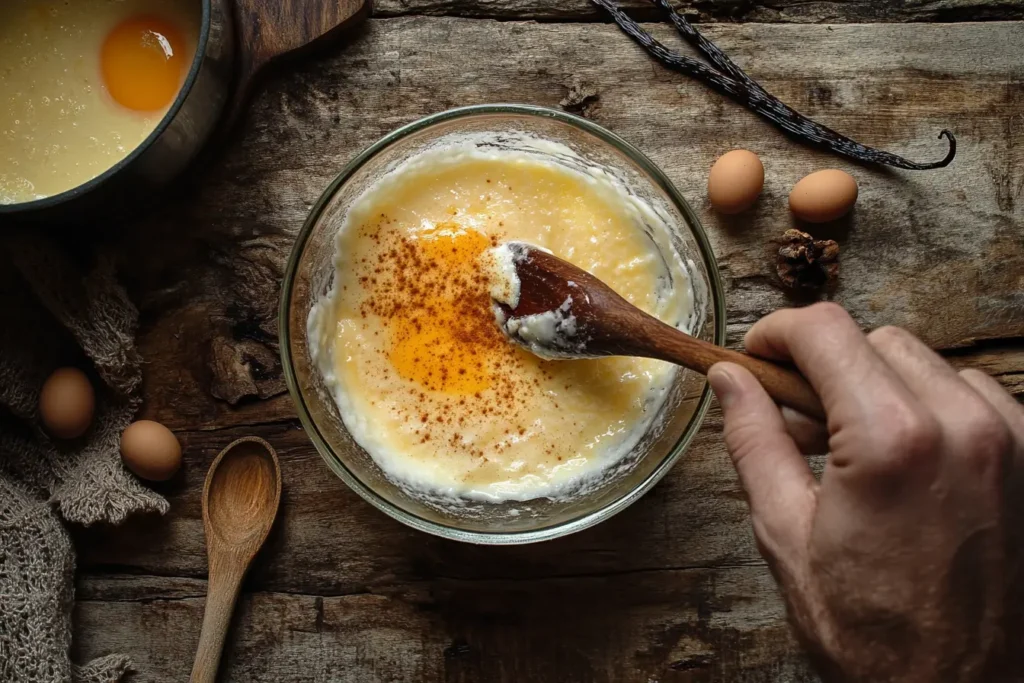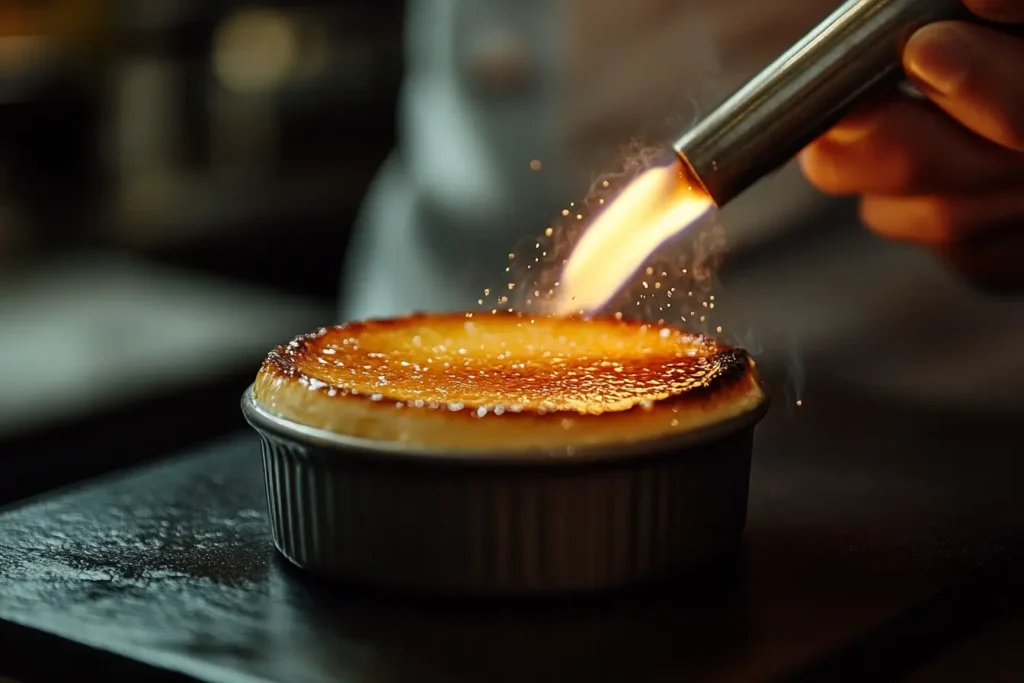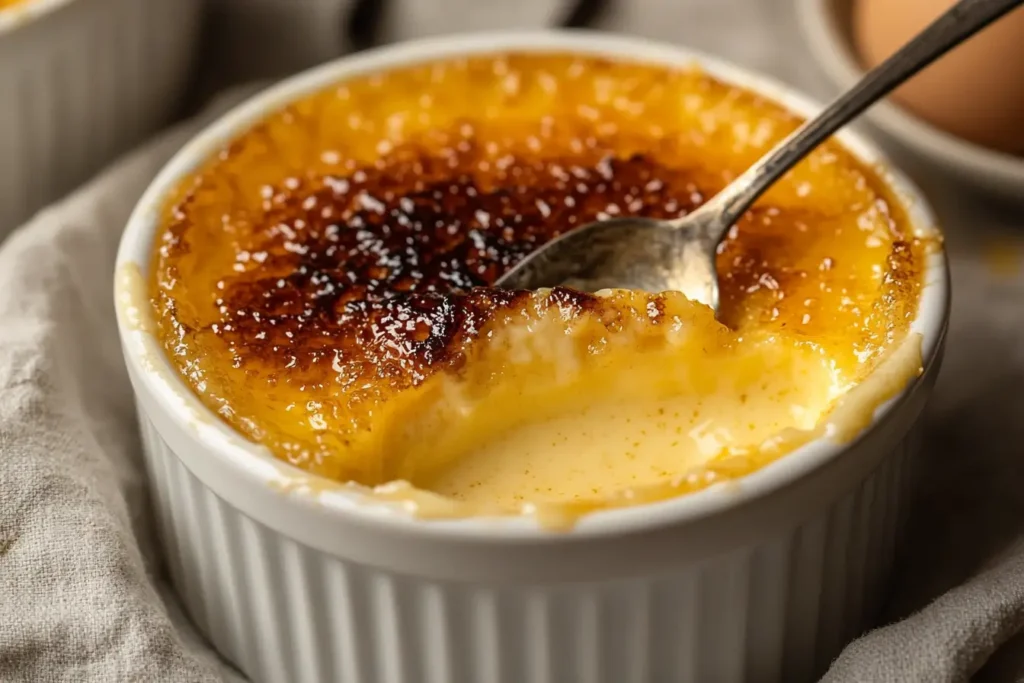Crème brûlée—just saying its name conjures images of sophistication and indulgence. This classic French dessert, with its silky custard base and a caramelized sugar crust, has captivated taste buds worldwide. But what exactly does crème brûlée taste like? Is it as simple as sweet vanilla custard, or is there more depth to this decadent delight? In this article, we’ll dive deep into the flavors, textures, and sensory appeal of crème brûlée, exploring everything from its origins to pairing suggestions. Ready to unlock the secrets behind its luxurious taste? Let’s begin
Unveiling the Taste of Crème Brûlée
What is Crème Brûlée and Why is It So Popular?
Crème brûlée is more than just a dessert—it’s a culinary experience. What does crème brûlée taste like? At its heart, this dish consists of a creamy, rich custard infused with delicate vanilla tones, topped with a layer of caramelized sugar that shatters like glass with the tap of a spoon. But what makes it truly special is the perfect balance it strikes between simplicity and elegance.
This dessert has stood the test of time, earning a place on fine-dining menus and home kitchens alike. Its appeal lies in the contrast of textures—the creamy custard versus the brittle sugar crust—and the way its flavors harmonize, delighting the senses with each bite.
The Sensory Appeal of Crème Brûlée
Crème brûlée’s flavor is a symphony of subtle sweetness and aromatic richness. The custard, made from cream, egg yolks, and sugar, delivers a smooth, velvety texture that practically melts in your mouth. Meanwhile, the caramelized topping provides a satisfying crunch and a hint of smoky bitterness, elevating the overall taste to a gourmet level.
Why Crème Brûlée Stands Out Among Desserts
Sure, there are plenty of custard-based desserts out there—crème caramel, flan, and panna cotta, to name a few. But crème brûlée holds its ground as an undisputed favorite due to its unique combination of simplicity and sophistication. It’s a dessert that appeals to both the adventurous foodie and the traditional sweet tooth.
In the next part, we’ll delve into the fascinating history of crème brûlée, exploring its origins and cultural significance. Stay tuned!
The Origins of Crème Brûlée
The Historical Background and Evolution of Crème Brûlée
Crème brûlée has a history as rich as its custard base, with origins steeped in culinary tradition. What does crème brûlée taste like when you consider its storied past? Though most people associate this decadent dessert with French cuisine, its beginnings are a subject of debate. Some historians trace its roots to 17th-century France, while others argue it first appeared in England as “burnt cream.” A similar Spanish dessert, crema catalana, adds another layer of intrigue to the story.
The French, however, solidified crème brûlée’s place in fine dining, making it synonymous with luxury and refinement. This custard-based dessert gained popularity in the late 19th century, becoming a hallmark of French pâtisseries.
Cultural Significance in French Cuisine
In France, crème brûlée isn’t just a dessert; it’s a symbol of tradition and elegance. The dessert is often featured in celebratory meals, showcasing its timeless appeal. Its ability to pair well with wines and its artistic presentation make it a staple in upscale dining.
Key Components of Crème Brûlée
The Custard Base

At the heart of crème brûlée is its silky-smooth custard base, a luxurious blend of cream, egg yolks, sugar, and vanilla. But what does crème brûlée taste like when these ingredients come together? The cream gives it richness, while the egg yolks provide structure and a creamy texture. Sugar adds sweetness without overpowering, and high-quality vanilla lends its iconic aroma.
Preparation plays a crucial role in achieving the perfect custard. The mixture is gently heated, ensuring the eggs don’t curdle, and then baked in a water bath to maintain its creamy consistency. This meticulous process guarantees a smooth, melt-in-your-mouth experience.
The Caramelized Sugar Topping of Crème Brûlée

The signature crunchy caramel layer is what sets crème brûlée apart. This topping is created by sprinkling a thin layer of sugar over the set custard, which is then caramelized with a culinary torch or broiler. The heat transforms the sugar into a golden, glass-like crust that cracks with a satisfying snap.
The slight bitterness of the caramelized sugar perfectly balances the custard’s sweetness, creating a harmonious flavor profile. The topping also adds a delightful contrast in texture, enhancing the overall experience.
In the next part, we’ll dive deeper into the intricate flavor profile of crème brûlée, exploring what makes its taste so unforgettable. Stay tuned!
What Does Crème Brûlée Taste Like?
The Creamy Custard
The custard in crème brûlée is a masterpiece of culinary artistry. Its rich, silky texture feels like velvet on the tongue, offering an indulgence that’s hard to match. The flavor? Pure, sweet vanilla with just enough depth to make each bite intriguing. The use of real vanilla beans elevates the dessert, adding subtle floral and woody undertones that linger delightfully. Every spoonful melts in your mouth, creating a sensory experience that’s both comforting and luxurious.
The Caramelized Sugar Crust
Then comes the magic of the caramelized sugar topping. It’s not just about taste—it’s the drama of cracking through that brittle, golden layer with your spoon. The flavor here contrasts beautifully with the custard beneath. Slightly bitter notes from the caramelization process complement the sweetness of the custard, creating a dynamic and exciting flavor profile. The topping’s crispness provides a satisfying crunch, adding an unexpected yet delightful texture.
Harmonious Blend of Textures and Flavors
What makes crème brûlée unforgettable is the interplay between its two main components. The creamy, smooth custard and the crunchy, caramelized crust seem like opposites, yet they work together perfectly. The balance of flavors—sweet, rich, and subtly bitter—ensures that no single bite is too overwhelming. It’s a dessert that invites you to slow down and savor, rewarding every bite with layers of flavor and texture that keep you coming back for more.
Regional and Modern Variations
Infused Flavors
Crème brûlée may have its roots in tradition, but modern chefs have found ways to innovate without losing its essence. Infused flavors have become a popular twist. Citrus zest, such as orange or lemon, adds a refreshing tang that cuts through the dessert’s richness. Coffee lovers will rejoice at espresso-infused versions, where deep, roasted notes pair wonderfully with the vanilla base. For an adult spin, liqueurs like Grand Marnier or Amaretto can be incorporated, adding complexity and warmth to the dish.
Alternative Toppings
While the classic sugar crust reigns supreme, creative variations abound. Some chefs experiment with alternative sugars, such as turbinado or coconut sugar, which impart unique flavors and textures to the crust. Garnishes like fresh berries, edible flowers, or even a dusting of cocoa powder can transform the presentation and add complementary flavor notes.
Whether traditional or modern, crème brûlée’s versatility ensures it remains a favorite for both purists and adventurers alike. In the next section, we’ll compare crème brûlée with other similar desserts, highlighting what makes it truly unique. Stay tuned!
Crème Brûlée vs. Similar Desserts
Crème Brûlée vs. Crème Caramel
At first glance, crème brûlée and crème caramel may seem like close cousins, but their differences are significant. Crème caramel, also known as flan in many regions, is a custard dessert topped with a soft caramel sauce, rather than the brittle caramelized layer found on crème brûlée. The preparation techniques differ as well; crème caramel is baked in a mold with caramel at the base, which melts into a syrupy topping when inverted.
In terms of texture, crème brûlée’s custard is thicker and creamier, offering a richer mouthfeel. Crème caramel, on the other hand, has a lighter, more gelatinous consistency due to the higher ratio of eggs to cream. Flavor-wise, crème caramel tends to be sweeter and less complex, whereas crème brûlée balances sweetness with the slight bitterness of its sugar crust.
Crème Brûlée vs. Panna Cotta
Panna cotta, an Italian dessert, differs even more from crème brûlée. It’s made using cream, sugar, and gelatin, which are chilled to set rather than baked. This results in a dessert that’s lighter and more jiggly compared to the dense, creamy texture of crème brûlée.
Panna cotta is often flavored with ingredients like coffee, chocolate, or fruit, offering a wider range of taste profiles. However, it lacks the crunchy sugar topping that defines crème brûlée. In a way, panna cotta is a minimalist dessert, while crème brûlée is a celebration of indulgence and texture.
The Sensory Appeal of Crème Brûlée
Visual Presentation
Crème brûlée is a feast for the eyes before it ever touches your tongue. The golden-brown, caramelized sugar topping gleams under the light, creating a visual allure that’s hard to resist. Served in individual ramekins, the dessert carries an air of elegance that elevates any dining experience. The moment you crack through the sugar crust, you’re treated to a glimpse of the creamy custard beneath—a contrast that heightens anticipation.
Aroma
The aroma of crème brûlée is equally captivating. The sweet scent of caramelized sugar mingles with the warm, inviting notes of vanilla, filling the air with an almost nostalgic fragrance. If the custard includes hints of citrus or liqueurs, those aromas add depth, creating a multi-layered olfactory experience.
Mouthfeel
Crème brûlée’s mouthfeel is its pièce de résistance. The moment the caramel crust cracks beneath your spoon, you’re greeted with a delightful crunch that gives way to the silky, smooth custard below. This interplay of textures is a defining feature, ensuring every bite feels as luxurious as it tastes.
In the next section, we’ll explore the culinary techniques that make crafting the perfect crème brûlée an art form. Stay tuned!
Crafting the Perfect Crème Brûlée
Importance of Ingredient Quality
The foundation of a truly unforgettable crème brûlée lies in the quality of its ingredients. Premium vanilla beans are a must—their rich aroma and natural sweetness elevate the custard to unparalleled levels of flavor. Opt for fresh cream with a high fat content to ensure a velvety, luxurious texture. When it comes to sugar, superfine granules work best for both the custard and the caramelized topping, ensuring smoothness and even caramelization.
Egg yolks are another critical component. They’re responsible for the custard’s silky consistency, so fresher is always better. By using only the highest-quality ingredients, you’re setting the stage for a dessert that truly shines.
Mastery of Caramelization
The caramelized sugar topping is the hallmark of crème brûlée, and achieving perfection requires finesse. Sprinkle an even layer of sugar across the surface of the set custard. Using a culinary torch, move the flame in small, circular motions to melt the sugar gradually. This prevents burning while creating the golden-brown crust that’s both visually appealing and deliciously crisp.
If a torch isn’t available, you can use the broiler in your oven—but keep a close eye on it! Over-caramelized sugar can develop an overly bitter taste, while under-caramelized sugar won’t achieve the signature crunch. Perfecting this technique is a true art, and with practice, you’ll master it in no time.
Enhancing the Crème Brûlée Experience
Beverage Pairings
Pairing crème brûlée with the right beverage can elevate the entire dining experience. Dessert wines like Sauternes or Moscato bring out the custard’s creamy richness, while the slight acidity of sparkling wines provides a refreshing contrast. For coffee enthusiasts, a dark roast or espresso enhances the dessert’s caramel notes, while a chai tea latte can add a warm, spiced twist to the flavors.
Accompaniments
While crème brûlée is a star on its own, a few thoughtful accompaniments can enhance its presentation and taste. Fresh berries—like raspberries or blackberries—add a tartness that balances the dessert’s sweetness. A crisp biscotti or delicate shortbread cookie provides additional texture, making each bite a well-rounded treat.
With these pairings and accompaniments, crème brûlée becomes more than a dessert—it transforms into a culinary experience worth savoring. In the next section, we’ll answer some frequently asked questions about this iconic dessert. Stay tuned!
FAQs About Crème Brûlée
What is the origin of crème brûlée?
The origin of crème brûlée has sparked debate among culinary historians. The French claim it as their own, with early recipes dating back to the 17th century. However, England offers competition with a similar dish known as “burnt cream,” which appeared in English cookbooks around the same period. Spain also enters the conversation with its crema catalana, a dessert remarkably similar to crème brûlée but flavored with cinnamon and citrus. While its exact birthplace remains uncertain, crème brûlée’s elegance and flavor have made it a global favorite.
How does crème brûlée differ from other custard desserts?
Crème brûlée stands apart due to its contrasting textures—a creamy custard base paired with a crisp, caramelized sugar crust. Unlike crème caramel, which has a soft caramel topping, or panna cotta, which uses gelatin for structure, crème brûlée offers a more indulgent experience with its velvety texture and bold flavors.
Can crème brûlée be made with non-dairy alternatives?
Yes, crème brûlée can be adapted for non-dairy diets. Coconut milk or almond milk are popular substitutes for cream, lending a unique flavor twist while maintaining a creamy texture. However, these alternatives may slightly alter the dessert’s signature richness. Experimentation is key to achieving the desired balance of flavor and consistency.
What are common mistakes to avoid when making crème brûlée?
Achieving the perfect crème brûlée requires attention to detail. Avoid overcooking the custard, as this can lead to a grainy texture. Uneven sugar layers can result in an inconsistent crust, so ensure a uniform sprinkle. Lastly, over-caramelizing the sugar can impart an unpleasant bitterness. Patience and precision are essential for success.
How should crème brûlée be stored and served?
Crème brûlée should be refrigerated once the custard is set, covered to prevent it from absorbing other fridge odors. Serve it chilled, but wait to caramelize the sugar until just before serving to maintain the crunch of the topping.
Is it possible to achieve the caramelized top without a torch?
Yes, a broiler can substitute for a torch. Place the ramekins under a preheated broiler, keeping a close eye to prevent burning. Another method is heating a metal spoon until red-hot and using it to caramelize the sugar, though this requires careful handling.
Conclusion
Crème brûlée is more than a dessert—it’s an experience, a celebration of contrasts and craftsmanship. Its silky custard base, delicately infused with vanilla, pairs perfectly with the satisfying crunch of caramelized sugar. This timeless treat has charmed dessert lovers for centuries with its balance of simplicity and sophistication.
Whether you enjoy it in a fine French restaurant or make it at home, crème brûlée never fails to impress. It connects us to a rich culinary heritage while offering a moment of pure indulgence. So next time you savor this iconic dessert, take a moment to appreciate the artistry behind each spoonful—and let its flavors transport you to a world of elegance and delight.


2 thoughts on “What Does Crème Brûlée Taste Like? A Sweet Symphony of Flavors”